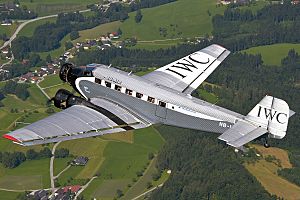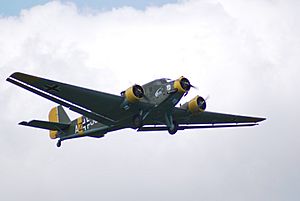Junkers Ju 52 facts for kids
Quick facts for kids Ju 52 |
|
|---|---|
 |
|
| JU Air Junkers Ju 52/3m HB/HOS in flight over Austria (July 2013) | |
| Role | Transport aircraft, medium bomber, airliner |
| Manufacturer | Junkers |
| Designer | Ernst Zindel |
| First flight | 13 October 1930 (Ju 52/1m); 7 March 1932 (Ju 52/3m) |
| Status | In limited use |
| Primary users | Luftwaffe Luft Hansa Spanish Air Force |
| Produced | 1931–1945 (Germany) 1945–1947 (France) 1945–1952 (Spain) |
| Number built | 4,845 |
The Junkers Ju 52/3m was a famous German aircraft, often called Tante Ju ("Aunt Ju") or Iron Annie. It was built from 1931 to 1952. This airplane was first designed with just one engine, but most of them were later made with three engines.
The Ju 52 was used for both civilian and military jobs during the 1930s and 1940s. As a civilian plane, it carried passengers and cargo for over 12 airlines, like Swissair and Deutsche Luft Hansa. In its military role, it served the Luftwaffe (Germany's air force) as a transport plane for troops and supplies. It was even used briefly as a bomber. The Ju 52 continued flying for many years after World War II, even into the 1980s, and some are still used today for sightseeing flights!
This tough aircraft was made of metal and could carry between 15 and 20 passengers. Its first flight was in 1931, and it started being used regularly in 1932. Lufhtansa was one of its main airline users. More than 4,800 Ju 52s were built in total.
Most Ju 52s were destroyed after World War II. However, 585 more were built after 1945. In France, the plane was made by a company called Avions Amiot during the war. They kept making it afterwards, calling it the Amiot AAC 1 Toucan. In Spain, another company, Construcciones Aeronáuticas SA, continued production as the CASA 352 and 352L. Today, four CASA 352s are still flying regularly.
You might have seen a CASA-built Ju 52/3m in the movie Where Eagles Dare (from 1968), starring Richard Burton and Clint Eastwood. It appears at the beginning and end of the film.
Contents
How the Ju 52 Was Used
Flying Passengers and Cargo
In 1932, a Canadian airline called Canadian Airways got one of the early Ju 52s. It was nicknamed the "Flying Boxcar" because it could carry about 3 tons of cargo. This plane was perfect for delivering large and heavy equipment to remote mining sites and other operations in Canada. The Ju 52 was very versatile; it could land on wheels, skis, or even floats on water.
Before the Nazi government took control of Junkers in 1935, the Ju 52/3m was mainly built as a passenger plane with 17 seats. Luft Hansa used it a lot. For example, it could fly from Berlin to Rome in about 8 hours. Luft Hansa eventually had 80 of these planes, flying routes across Europe, Asia, and South America.
Military Missions (1932–1945)
The Ju 52 was also used by several air forces. The Colombian Air Force used three Ju 52s as floatplanes (planes that land on water) during a conflict in 1932–1933. Later, they got more Ju 52s for transport, keeping them in service until after World War II.
Bolivia also bought four Ju 52s during the Chaco War (1932–1935). These planes were mainly used for carrying supplies and for medical evacuation (flying wounded people to safety). During that war, the Ju 52s transported over 4,400 tons of cargo to the front lines.
In 1934, Junkers was asked to make a bomber version of the Ju 52/3m for the secret German air force, the Luftwaffe. These planes could carry up to 1,500 kg (about 3,300 pounds) of bombs. They also had two machine guns for defense.

The bomber version could easily be changed into a transport plane. The Ju 52 ended up being used much more than expected. It became the Luftwaffe's main bomber for a while until newer planes were ready.
The Ju 52 first saw military action in the Spanish Civil War in 1936. It was used as both a bomber and a transport plane. After this war, no more bomber versions were built. However, it was used again as a bomber during the bombing of Warsaw in September 1939. After that, the Luftwaffe mainly used the Ju 52 for transport during World War II, including dropping paratroopers (soldiers who jump from planes).
Hitler's Personal Plane
Adolf Hitler used a Deutsche Luft Hansa Ju 52 during his election campaign in 1932. He preferred flying instead of taking the train. After he became Chancellor of Germany in 1933, he got his own personal Ju 52. His pilot was Hans Baur. This special plane was named Immelmann II, after a famous pilot from World War I named Max Immelmann. Its registration number was D-2600.
As Hitler's power grew, his personal air fleet also grew to almost 50 aircraft. Most of these were Ju 52s. They were based at Berlin Tempelhof Airport and also flew other important members of his government and war staff.
Images for kids
-
Ju 52/1m replica (converted from 52/3m) of "CF-ARM" at the Royal Aviation Museum of Western Canada, Winnipeg, Manitoba, Canada
-
Ju 52s damaged in Crete, 1941
-
A Luftwaffe Ju 52 being serviced in Crete in 1943: Note the narrow-chord Townend ring on the central engine and the deeper-chord NACA cowlings on the wing engines.
-
Ju 52 HB-HOS on sightseeing tour at Degerfeld airfield (2016)
-
French-built AAC.1 of STA at Manchester Airport in 1948: This aircraft is preserved in Belgrade.
-
Junkers C-79, s/n 42-52883, at Howard Field, Panama Canal Zone, late 1942 with the USAAF 20th Transportation Squadron, Sixth Air Force.
-
CASA 352 (license-built Junkers Ju 52/3m) in Ju-Air markings at Zürich airport
See also
 In Spanish: Junkers Ju 52 para niños
In Spanish: Junkers Ju 52 para niños























